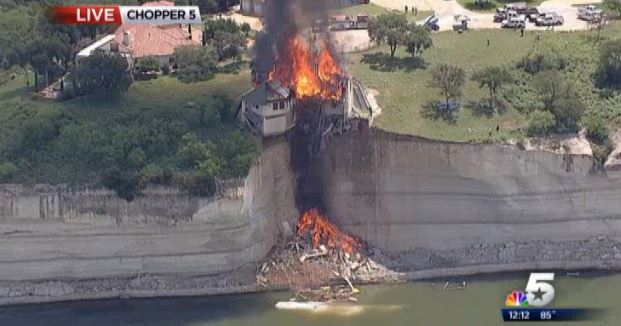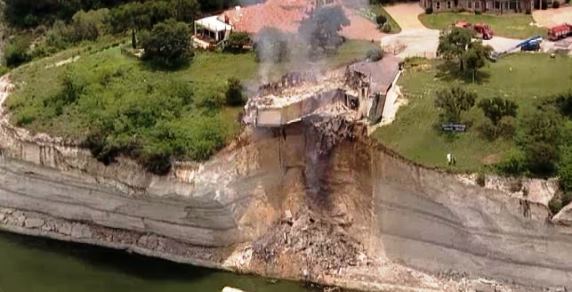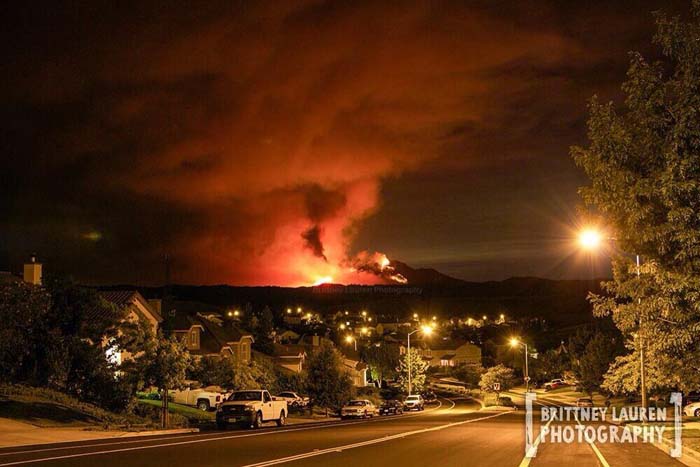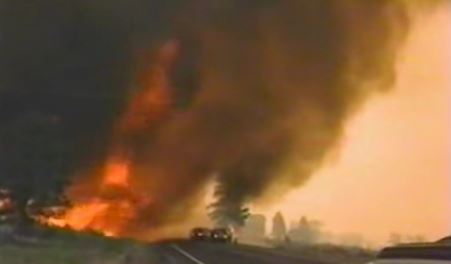(Originally published at 9:19 a.m. CT, June 13, 2014)
House teetering on cliff to be prescribed burned
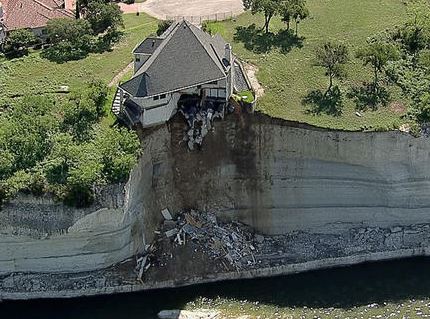
A house at the top of a cliff over Lake Whitney in Texas will be burned intentionally Friday morning. The cliff below part of the house has fallen away, leaving the house precariously teetering. The house will be burned, which is considered a better option than allowing it to fall into the lake where the debris would have to be removed.
A crew is prepping the house by breaking out windows and adding bales of hay soaked in diesel fuel to the interior.
The prescribed fire is being covered live by a television station in Texas.
(UPDATE at 10:15 a.m. CT, June 13, 2014)
Ignition has begun. Firefighters are on scene applying water between the burning home and a nearby house, perhaps to minimize damage to a couple of trees.
(UPDATE at 11:36 a.m. CT, June 13, 2014)
It’s pretty much over:
The photos are from NBCDFW.
Funeral services for Nevada firefighter
The funeral services for Donovan Artie Garcia Jr. will be held today, Friday, June 13. Mr. Garcia, the Assistant Chief of the Hungry Valley, Nevada fire department, died of a heart attack while participating in wildland fire training June 5. Services will be in Reno at 11 a.m. at the Hungry Valley Gymnasium, 9070 Eagle Canyon Drive.
MD-87 air tanker makes first drops
Erickson Aero Tanker’s two MD-87 air tankers, T-101 and T-105, made numerous drops on the Two Bulls Fire near Bend, Oregon shortly after they became certified and reported for duty. Wallowa.com has an article in which they quote pilot Brent Conner:
“I mean, I always wanted to be flying propeller planes, so this is new for me, and for most of us in this business,” he said.
“We can hold it in check, as we did with this fire, for about two days with retardant,” he said. “That gave them enough time to get the other flank taken care of.”
While it’s a job he’s done countless times before, it was Conner’s first weekend in real wildfire action with the Aero Tanker.
“It was a little nerve-wracking, actually,” he said. “We hadn’t been on a fire yet, the fire’s only 15 miles away. We barely had time to get the airplane cleaned up and we were already putting the flaps down, slowing down and getting ready to go.”
More information about the MD-87s is at Fire Aviation.
Reward for information about Two Bulls Fire
And speaking of the Two Bulls Fire at Bend, Oregon, the reward for information leading to a conviction of the person or persons responsible for setting the 6,908-acre fire has increased to $31,500. Anyone with information that could help identify suspects in the fire is asked to contact the Crime Stoppers Tip Line at 1-877-876-8477 (TIPS).
Hot pink may be the new color of fire retardant
The Missoula Technology Development Center is testing new colors for the fire retardant that is dropped by air tankers and helicopters. Below are excerpts from KPAX:
Over the last three years, some pilots have been complaining that the bright orange retardant is hard to see. “Particularly in late season when we’ve got grasses and trees that start turning color,” said Zylstra. With that concern, researchers at the US Forest Service’s Technology and Development Center in Missoula began looking into a solution, potentially a hot pink colored slurry. “So we run a product through a variety of different tests in our lab before it’s used out in the field,” said Zylstra.
[…]
The first batch of the hot pink slurry will be tested at four air tanker bases in California in regions predicted to have busy firefighting season.
Helitack crews train in Idaho
MagicValley.com has an article about U.S. Forest Service and Bureau of Land Management helitack crews training for the upcoming wildfire season.
Austin, Texas to get wildfire detection system
The Austin City Council voted to purchase a system of sensors mounted on towers that can detect smoke. The approval will allow the installation of two towers which will be tested for a year. At the end of the year they may decide to expand the system. In 2013, West Lake Hills, a community near Austin, also approved the acquisition of a similar system. It can detect smoke within 6 miles by rotating their sensors, completing a 360-degree rotation every 8 to 12 minutes, during which it takes images, analyzes, and then transmits those images for secondary analysis. If possible fire events are detected, the system alerts fire authorities.
Hotshots assist with prescribed fire on military base
The Laguna Hot Shots, based at Descanso, California, helped conduct a prescribed fire at Marine Corps Air Station Miramar on Thursday north of San Diego. Below is an excerpt from an article at 10News:
As a formation of Marine FA/18’s passed overhead to land at MCAS Miramar, members of the Laguna Hotshot crew were setting fire to the east side of the base.
The prescribed burn, as it’s called, is part of an annual brush management system put in place after the 2003 wildfire.
“After it burned more than 17,000 acres, the Cedar Fire really opened our eyes to a strong brush management program at the air station,” said Miramar Fire Operations Chief Paul Thompkins.
Construction begins on firefighter memorial in Prescott
Construction has started on a memorial in a cemetery in Prescott, Arizona for the members of the Granite Mountain Hotshots that were killed while fighting the Yarnell Hill Fire on June 30, 2013.
Below is an excerpt from KJZZ.org:
Construction is starting on a cemetery memorial for 19 firefighters killed in the Yarnell Hill wildfire, nearly a year after the fire started near Prescott. Each firefighter will have a plot and a bronze grave marker at the state-owned Pioneers’ Home Cemetery in Prescott. The plots are surrounded by a two-foot wall where mourners can sit.
Officials say 10 of the Granite Mountain Hotshot firefighters are already buried there. They say there’s room for family members to be buried alongside them.
The state designated a new section of the cemetery for the hotshots and charged $100 per grave site, instead of the usual $900.

